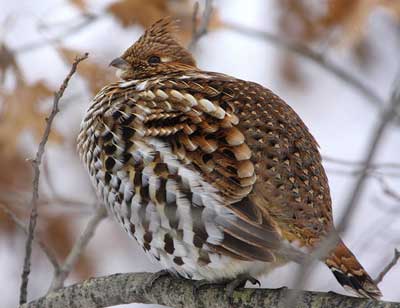Ruffed Grouse
By Rick Horton, National Wild Turkey Federation
Ruffed grouse reach their peak densities in aspen forests, but can do well in oak systems with proper management. Grouse need young, dense forests for courtship and brood-rearing, and more mature trees for other parts of their annual life cycle. For example:

- Male grouse perform mating displays in dense stands, usually within sight of mature trees.
- Females nest on the ground in mature stands, where the open understory allows them to see predators approaching.
- Females rear young in very dense, young stands, where the stem density protects them from predators.
- Both sexes winter in or near mature aspen stands, feeding on male aspen flower buds, and hazel or birch catkins.
For this reason, optimal grouse habitat occurs where small (3-5 acres) forest stands cut on frequent rotations are interspersed with one another, providing all of the needed age classes in close proximity.
Habitat needs
As already mentioned, ruffed grouse need the cover of young forests to thrive. For instance, the high stem densities of young woods help protect young birds and displaying males from predators.
In winter, grouse escape predation and maintain body heat by diving into deep snow and roosting under it, leaving at dawn and dusk to feed. If there is too little snow, grouse take refuge in blow-downs, dense vegetation, or in conifer stands. Icy crusts on snow can trap grouse in their roosts.
Food is not limiting for grouse in summer, when their diet consists of all manner of green leafy material, berries, fruits, nuts, mushrooms, buds, and occasional insects. In winter and early spring, though, grouse eat tree and shrub flower buds and catkins almost exclusively.
Recommendations for attracting more grouse
- Provide a mixture of dense, young stands and mature stands near to one another. Aspen should be cut on a 40-year rotation, with one-quarter of each 40-acre stand in a different age class. Oak should be cut on longer rotations depending on species and soil conditions.
- While grouse use pines and other conifers for shelter during times of little snow cover in winter, conifers also serve as year-round perches for avian predators of grouse. For this reason, the presence of conifers is detrimental to grouse survival. If you want conifers on your land, manage for scattered clumps rather than individual trees.
- Drumming logs usually aren’t limiting, but you can construct logs during or after a timber harvest. Place a hardwood log 10-inches or larger in diameter and at least eight feet in length next to a three-foot tall stump, parallel to the slope of the land. Clear the ground of debris for 20 yards in all directions, and make sure mature aspen are within 150 feet of the log. Logs should also be spaced at least 100 feet apart.
- Grouse will feed on clover seeded into trails and log landings, but they don’t need it. They have plenty of natural foods during the growing season. In fact, drawing the birds into the open can expose them to predators. Nonetheless, this practice does make hunting grouse along trails easier in the fall.
